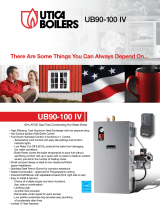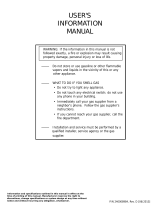
4
1. Stainless steel heat exchanger
Allows system water to fl ow through specially designed
coils for maximum heat transfer, while providing protection
against fl ue gas corrosion. The coils are encased in a jacket that
contains the combustion process.
2. Combustion chamber access cover
Allows access to the combustion side of the heat exchanger
coils.
3. Blower
The blower pulls in air and gas through the venturi (item 5).
Air and gas mix inside the blower and are pushed into the
burner, where they burn inside the combustion chamber.
4. Gas valve
The gas valve senses the negative pressure created by the
blower, allowing gas to fl ow only if the gas valve is powered and
combustion air is fl owing.
5. Venturi
The venturi controls air and gas fl ow into the burner.
6. Flue gas sensor (limit rated - not shown)
This sensor monitors the fl ue gas exit temperature. The
control module will modulate and shut down the boiler if the
fl ue gas temperature gets too hot. This protects the fl ue pipe from
overheating.
7. Boiler outlet temperature sensor (housed with the
high limit sensor)
This sensor monitors boiler outlet water temperature (system
supply). If selected as the controlling sensor, the control
module adjusts boiler fi ring rate so the outlet temperature is
correct.
8. Boiler inlet temperature sensor
This sensor monitors return water temperature (system
return). If selected as the controlling sensor, the control
module adjusts the boiler fi ring rate so the inlet temperature is
correct.
9. Temperature and pressure gauge (fi eld installed, not
shown)
Monitors the outlet temperature of the boiler as well as the
system water pressure.
10. Electronic LCD display
The electronic display consists of 4 buttons, a navigation dial
and a multiple line liquid crystal display.
11. Flue pipe assembly
Factory-supplied components for complete venting
system.
12. Burner (not shown)
Made with metal fi ber and stainless steel construction, the
burner uses pre-mixed air and gas and provides a wide range of
fi ring rates.
13. Water outlet (system supply)
A 1-1/2" or 2" NPT (depending on the model) water
connection that supplies hot water to the system.
14. Water inlet (system return)
A 1-1/2" or 2" NPT (depending on the model) water connection
that returns water from the system to the heat exchanger.
15. Gas connection pipe
Threaded pipe connection of 1". This pipe should be connected
to the incoming gas supply for the purpose of delivering gas to
the boiler.
16. SMART SYSTEM Control Module
The SMART SYSTEM Control responds to internal and
external signals and controls the blower, gas valve, and pumps
to meet the heating demand.
17. Manual air vent
Designed to remove trapped air from the heat exchanger
coils.
18. Air intake
Provides combustion air to the appliance.
19. Air Intake Cover
Provides protection from outdoor elements.
20. High voltage junction box
The junction box contains the connection points for the line
voltage power and all pumps.
21. Boiler drain port
Location from which the heat exchanger can be drained.
22. Low voltage connection board
The connection board is used to connect external low voltage
devices.
23. Low voltage wiring connections (plugs)
Conduit connection points for the low voltage connection
board.
24. Condensate drain connection
Connects the condensate drain line to a 1/2” PVC union.
25. Access cover - front
Provides access to the gas train and the heat exchanger.
26. Ignition electrode
Provides direct spark for igniting the burner.
27. Flame inspection window
The quartz glass window provides a view of the burner surface
and fl ame.
28. Gas shutoff valve
Manual valve used to isolate the gas valve from the gas supply.
29. Relief valve
Protects the heat exchanger from an over pressure condition.
The relief valve provided with the unit is set at 50 PSI.
30. Flame sensor
Used by the control module to detect the presence of burner
fl ame.
31. Line voltage wiring connections (knockouts)
Conduit connection points for the high voltage junction box.
32. Top panel
Removable panel to gain access to the internal components.
33. Power switch
Turns 120 VAC ON/OFF to the boiler.
34. Leveling legs
Used to allow the heat exchanger to be leveled. This is needed
for the proper draining of the condensate from the combustion
chamber.
35. Air shroud (Model 501 only)
The air shroud controls air and gas fl ow into the burner.
36. Air pressure switch
The air pressure switch detects blocked fl ue/inlet conditions.
break the control circuit, shutting the boiler down.
37. Pump relay board
The pump relay board is used to connect the boiler, system and
DHW pumps.
38. Transformer (not shown)
The transformer provides 24V power to the integrated control.
39. High limit sensor (housed with the outlet temperature
sensor)
Device that monitors the outlet water temperature. If the
temperature exceeds its setting, the integrated control will break
the control circuit, shutting the boiler down.
40. Over-temp switch (located underneath vent cover -
not shown)
An electrical switch designed to shut down boiler operation in
the event the outer back of the heat exchanger, directly above the
fl ue connection exceeds 604°F (318°C). This is a one time
switch and could warrant a heat exchanger replacement. Check
the integrity of the rear refractory at the back of the upper coil if
the switch opens.
41. Vent Cover
Covers Over-temp switch and fl ue collar with fl ue sensor.
42. Flow switch
The fl ow switch is a safety device that ensures fl ow through
the heat exchanger during operation. This appliance is low
mass and should never be operated without fl ow. The fl ow
switch makes contact when fl ow is detected and allows the unit
to operate. If fl ow is discontinued during operation for any
reason the fl ow switch will break the control circuit and the
unit wll shut down.
43. Burner door temperature switch
An electrical switch designed to shut down boiler operation
in the event the combustion chamber access cover exceeds
500°F (260°C). This switch may only be reset by a qualifi ed
boiler service technician AFTER the underlying cause has been
identifi ed and corrected. Check the integrity of the front
refractory on the inside of the combustion chamber access
cover if the switch opens.
Outdoor Knight XL Installation & Operation Manual
The Outdoor Knight XL - How it works...






















